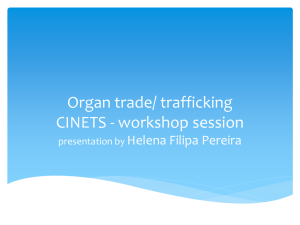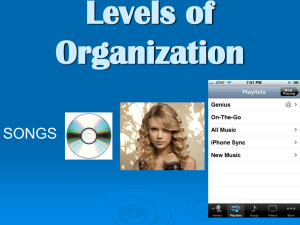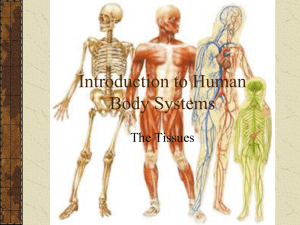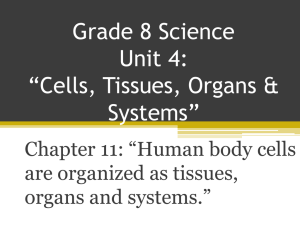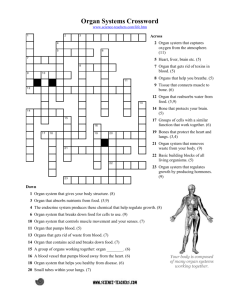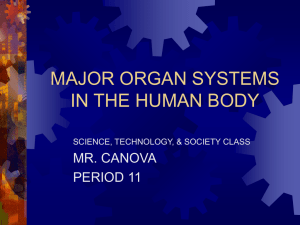Human Organ Systems Unit - Science Horizons Initiative
advertisement
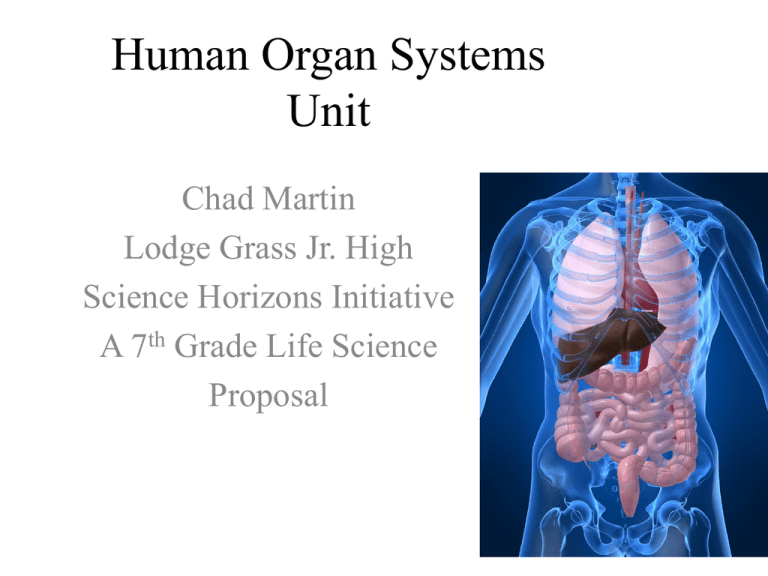
Human Organ Systems Unit Chad Martin Lodge Grass Jr. High Science Horizons Initiative A 7th Grade Life Science Proposal • Understandings: Students will compare the structure and function of cells, tissues, organs and organ systems in the human. • Essential Question: What are the structure, function and relationship among cells, tissues, organs and organ systems in the human? Montana K-12 Science Content Standards End of Grade 8, Content Standard 3.1 states that students will study the relationship among cell, tissue, organ and organ systems in the human. Ace Curriculum Standards Ace Curriculum Standards LS 11.0, and 13.0 state that students will create a testable question and hypothesis. They will analyze data with a graph. Bloom’s Taxonomy Following Bloom’s Taxonomy, students will evaluate data which includes norms, controls and multiple assessments. Students Will Know In Section 1 students will describe how tissues, organs and organ systems are related. They will list 11 organ systems. They will identify how organ systems work together to maintain homeostasis. In Section 2 students will identify the major organs of the skeletal system. They will describe four functions of bones. They will describe three joints. In section 3 students will list three kinds of muscle tissue. They will describe how skeletal muscles move bones. They will compare aerobic exercise to resistance exercise. They will describe two muscular system injuries. In section 4 students will list four functions of skin. They will describe the two layers of skin. They will describe the function of hair and nails. They will describe two kinds of damage that can affect the skin. Holding Ice Start-Up Activity Performance tasks: The students will do a StartUp Activity comparing a hand with no ice to a hand with ice using thermometers and an infared thermometer. They will write a testable question and hypothesis. They will record, graph and evaluate temperature data. They will write answers to higher level thinking questions. Text Assessment • The students will read and answer the question in the four sections in the book about organ systems, the skeletal system, the muscular system and the integumentary system. After completing the four sections the students will answer the Chapter Review questions. They will then take the Chapter Test. Creating a Brochure The students will choose an organ system and create a brochure (both sides of photocopy paper folded into thirds) about it. After examining examples of brochures they will use a variety of books, internet and other sources to draw, describe and discuss cells, tissues, organs and organ systems. They will be graded on the rubric of labeling, explaining, creativity and art. The brochures will be displayed in the hall display case for everyone to see. Athletic Physical Form The students will check and discuss how many times each organ system was evaluated in the athletic physical. The Circulatory System and Exercise Start-Up Activity The students will do a Start-Up Activity about exercising the heart. Students will learn to use a stethoscope to monitor their heart, take their pulse with their fingers and take their systolic and diastolic blood pressure. They will use the Vernier-Texas Instruments CBL (computer based lab) System to graph their heart beats. They will Take their resting pulse and blood pressure. They will do jumping jacks for 1 minute. They will then check their pulse and blood pressure. After resting for 5 minutes they will check their pulse and blood pressure again. They will answer the Analysis questions. Human Organ System Science Fair Projects The students will choose 1 of 5 possible science fair projects: 1. Off All the Nerve about which parts of the body are more sensitive to touch, 2. No Nose No Taste about how smell influences taste, 3. Fingerprint Findings checking similarity of fingerprints in a family, 4. Are Dogs Colorblind? 5. Build Your Own Lungs. www.education.com science fair project ideas then check the life science on the bottom and health and fitness in the blank on the right opens up about 500 science fair experiments. The students will do the experiment, write the results and answer the research questions. Students that make a large display about their experiment will get extra credit. Materials List Start-Up Activities: 2 thermometers for each student 1 infared thermometer 1 stethoscope 1 blood pressure cuff with gauge 1 wrist electric blood pressure & pulse cuff 1 Vernier LabQuest Physiology Package including an EKG Sensor Science Fair Project Materials: Ink pad and ink for finger prints 4 flavors of jelly beans for taste experiment Rubber bands, 2 liter bottle, Y tube, tape balloons for Build Your Own Lungs Treats for dogs in the colorblind project 2 pencils and tape for the touch test The Impact On Understanding Science This unit is an inquiry based opportunity for seventh grade students to learn about how their bodies function. The students are interested in this subject and will enthusiastically study any information presented to them as well as apply what they learn from the labs to their lives. The students will develop higher level thinking, communication, goal setting and the planning process in science. They will apply science knowledge and skills to solving problems, conducting research, using scientific equipment properly, applying knowledge of the relationship between humans and the environment and develop technical skills.






